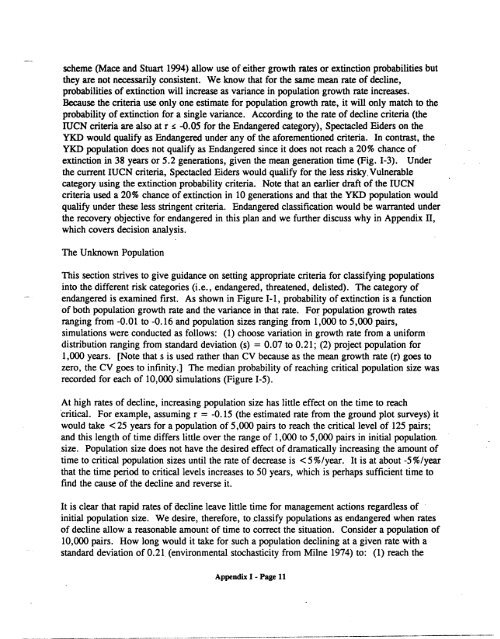A. Status of the Spectacled Eider - U.S. Fish and Wildlife Service
A. Status of the Spectacled Eider - U.S. Fish and Wildlife Service
A. Status of the Spectacled Eider - U.S. Fish and Wildlife Service
You also want an ePaper? Increase the reach of your titles
YUMPU automatically turns print PDFs into web optimized ePapers that Google loves.
scheme (Mace <strong>and</strong> Stuart 1994) allow use <strong>of</strong> ei<strong>the</strong>r growth rates or extinction probabilities but<br />
<strong>the</strong>y are not necessarily consistent. We know that for <strong>the</strong> same mean rate <strong>of</strong> decline,<br />
probabilities <strong>of</strong> extinction will increase as variance in population growth rate increases.<br />
Because <strong>the</strong> criteria use only one estimate for population growth rate, it will only match to <strong>the</strong><br />
probability <strong>of</strong> extinction for a single variance. According to <strong>the</strong> rate <strong>of</strong> decline criteria (<strong>the</strong><br />
IUCN criteria are also at r =-0.05 for <strong>the</strong> Endangered category), <strong>Spectacled</strong> <strong>Eider</strong>s on <strong>the</strong><br />
YKD would qualify as Endangered under any <strong>of</strong> <strong>the</strong> aforementioned criteria. In contrast, <strong>the</strong><br />
YKD population does not qualify as Endangered since it does not reach a 20% chance <strong>of</strong><br />
extinction in 38 years or 5.2 generations, given <strong>the</strong> mean generation time (Fig. 1-3). Under<br />
<strong>the</strong> current IUCN criteria, <strong>Spectacled</strong> <strong>Eider</strong>s would qualify for <strong>the</strong> less risky. Vulnerable<br />
category using <strong>the</strong> extinction probability criteria. Note that an earlier draft <strong>of</strong> <strong>the</strong> IUCN<br />
criteria used a 20% chance <strong>of</strong> extinction in 10 generations <strong>and</strong> that <strong>the</strong> YKD population would<br />
qualify under <strong>the</strong>se less stringent criteria. Endangered classification would be warranted under<br />
<strong>the</strong> recovery objective for endangered in this plan <strong>and</strong> we fur<strong>the</strong>r discuss why in Appendix II,<br />
which covers decision analysis.<br />
The Unknown Population<br />
This section strives to give guidance on setting appropriate criteria for classifying populations<br />
into <strong>the</strong> different risk categories (i.e., endangered, threatened, delisted). The category <strong>of</strong><br />
endangered is examined first. As shown in Figure I-i, probability <strong>of</strong> extinction is a function<br />
<strong>of</strong> both population growth rate <strong>and</strong> <strong>the</strong> variance in that rate. For population growth rates<br />
ranging from -0.01 to -0.16 <strong>and</strong> population sizes ranging from 1,000 to 5,000 pairs,<br />
simulations were conducted as follows: (1) choose variation in growth rate from a uniform<br />
distribution ranging from st<strong>and</strong>ard deviation (s) = 0.07 to 0.21; (2) project population for<br />
1,000 years. [Notethat s is used ra<strong>the</strong>r than CV because as <strong>the</strong> mean growth rate (r) goes to<br />
zero, <strong>the</strong> CV goes to infinity.] The median probability <strong>of</strong> reaching critical population size was<br />
recorded for each <strong>of</strong> 10,000 simulations (Figure 1-5).<br />
At high rates <strong>of</strong> decline, increasing population size has little effect on <strong>the</strong> time to reach<br />
critical. For example, assuming r = -0.15 (<strong>the</strong> estimated rate from <strong>the</strong> ground plot surveys) it<br />
would take

















